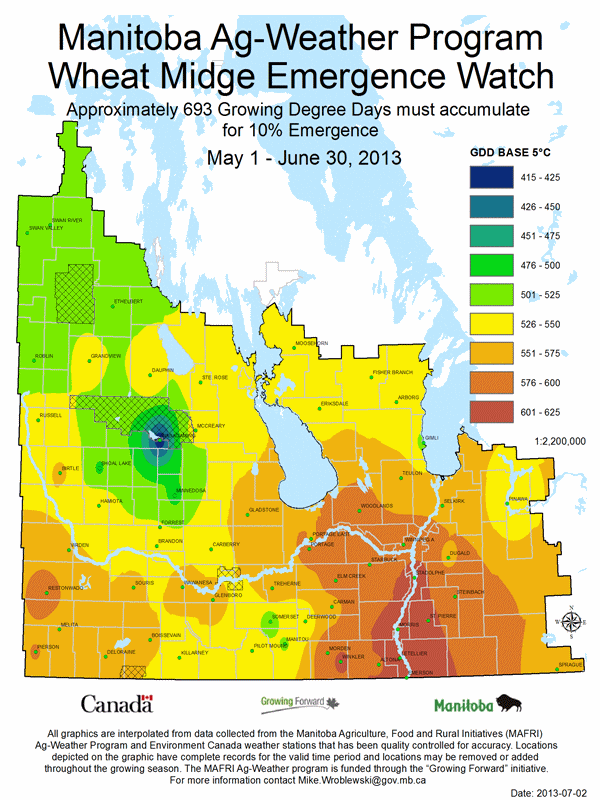Manitoba Insect and Disease Update: Week of July 1, 2013
Compiled by:
- John Gavloski, Entomologist
Manitoba Agriculture, Food and Rural Initiatives
Phone: (204) 745-5668
Fax: (204) 745-5690. - Holly Derksen, Plant Pathologist
Manitoba Agriculture, Food and Rural Initiatives
Phone: (204) 750-4248
Fax: (204) 745-5690
To report observations on insects or plant pathogens that may be of interest or importance to farmers and agronomists in Manitoba, please send messages to the above contact address.
To be placed on an E-mail list so you will be notified immediately when new Manitoba Insect and Disease Updates are posted, please contact John Gavloski at the address or numbers listed above.
Recent Insect and Plant Pathogen Activity
Grasshoppers
Levels of grasshoppers are high in many areas, and some insecticide applications are occurring. In many instances it is the edges of the field that are being treated. If grasshopper populations are high, they can be easier to manage when they are in their juvenile stages and not yet able to fly, which is the current situation for our pest species. Egg hatch should be nearly complete.
Generalized thresholds have been developed to aid in decision making for grasshoppers. These are nominal thresholds meant to serve as guidelines. The same set of thresholds get used for many crops (cereals, soybeans, etc.).
Grasshopper Severity Ratings Note: The threatening rating is generally considered the action threshold for grasshoppers. | ||||
|---|---|---|---|---|
| Nymphs per square metre | Adults per square metre | |||
| Rating | Margin | Field | Margin | Field |
| Light | 25 - 35 | 15 - 23 | 10 - 20 | 3 - 7 |
| Threatening | 50 - 75 | 30 - 45 | 21 - 40 | 8 - 14 |
| Severe | 100 - 150 | 60 - 90 | 41 - 80 | 15 - 28 |
| Very severe | 200+ | 120 | 80+ | 28+ |
Cereal Leaf Beetles
Cereal leaf beetles have been found in some wheat fields in the Treherne area. Numbers are low and not economical, but what is interesting is that until recently it was thought to be restricted in Manitoba to the areas around Swan River in Northwest Manitoba. Currently it is larvae that are being found. If you find larvae of cereal leaf beetle on cereal leaves, please let me know. The larvae may look like a drop of oil, as they have a habit of covering themselves with a substance containing their own feces. This insect is controlled very well by parasitoids, which have been established in the Swan River area after it was found there. Now that it is being found in other areas of Manitoba, what we need to figure out is are the parasitoids also present in these areas. This can be determined by collecting larvae (ideally about 50) which will be sent to an entomologist with AAFC in Lethbridge, who is studying parasitism levels in cereal leaf beetle and can tell us what the percent parasitism in a population is. So if you are seeing these, please let me know. Or, collect a sample and some leaf material for them to feed on and send them to me. Make sure larvae from different fields are in different containers and label containers with the field location, date collected, and crop present. The photos below show a larva of cereal leaf beetle (left) and adult beetle (right).
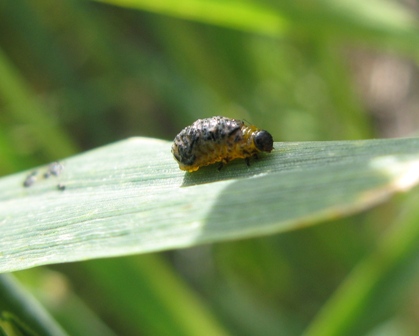
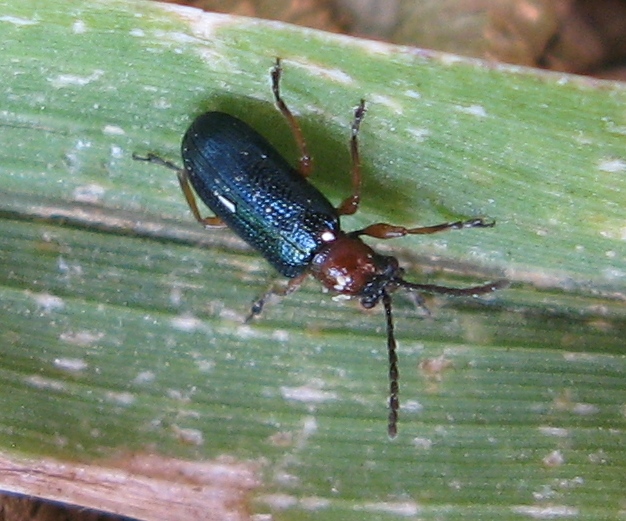
Alfalfa Weevil
Alfalfa weevil have been reported to have caused damage to alfalfa in the Interlake and Eastern regions of Manitoba. Cutting the alfalfa can kill larvae that are present. Larvae can not move far, so after a cut many will desiccate or starve. Do keep on eye on the regrowth however. If the regrowth comes back quickly, before the larvae have died, and there are more than 2 active larvae per crown on average, than controls could be beneficial. Also consider the stage of the larvae. Many will turn to pupae soon. Below is a photo of alfalfa weevil larvae.
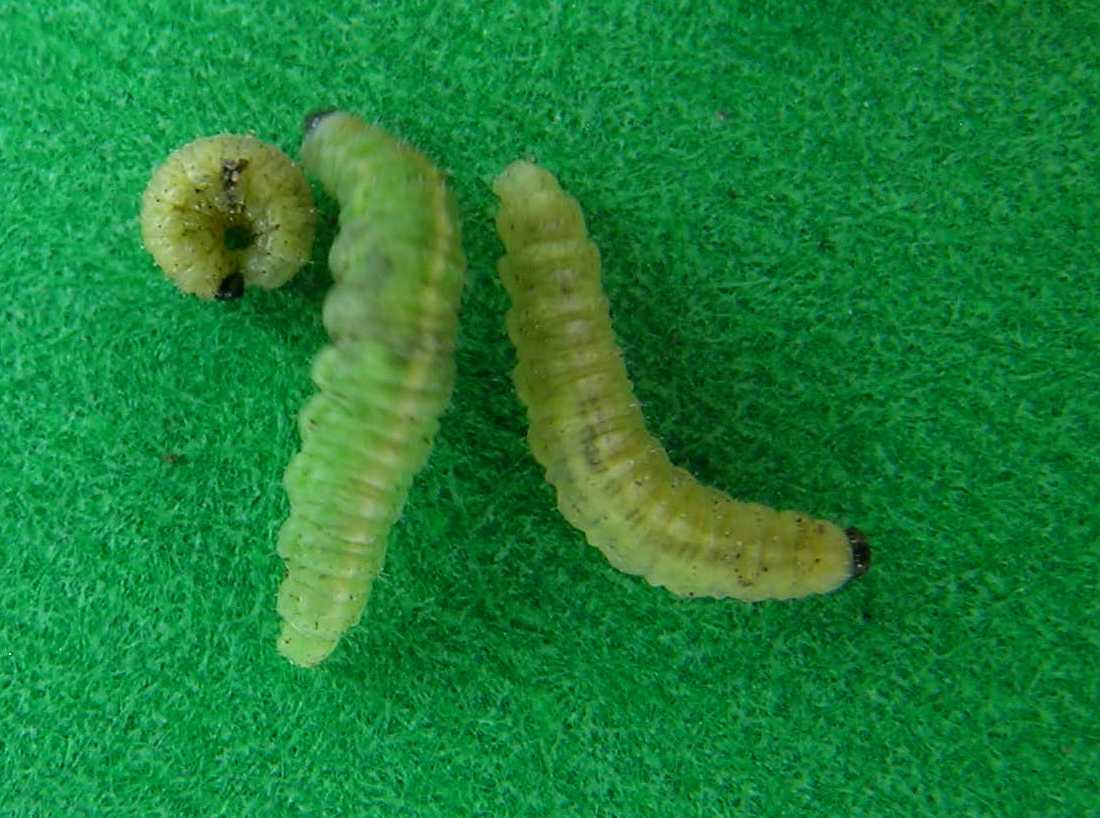
Fungicide Timing and Disease Risk
Crops across the province are advancing quickly and many are nearing or have reached the optimal time for a fungicide application for disease suppression. Moisture levels across the province are adequate or more than adequate for fungal disease infection. In some areas of the province there has not been a significant rainfall event in over a week, but the humidity has provided more than enough free moisture for spore development and release - especially in thick canopies.
Consult the following table as a reminder regarding the optimal timing for fungicide applications:
| Crop | Disease | Optimal Fungicide Timing |
|---|---|---|
| Canola | Sclerotinia | 20-30% flowering |
| Cereals | Leaf disease | After flag leaf emergence |
| Wheat | Fusarium Head Blight | Early anthesis |
| Barley | Fusarium Head Blight | Full head emergence |
| Peas | Ascochyta/Mycosphaerella blight | Early flowering |
| Dry Beans | White mould | Early flowering |
Check product labels for specific recommendations and remember it is better to be early than too late!
Downy Mildew in Canola
Symptoms of downy mildew in canola have been observed in a canola field in the southern part of the province (see images below). These symptoms were only observed on lower leaves where there is longer periods of free moisture. Typical symptoms of downy mildew include irregularly shaped lesions on the upper surface of the leaves with mycelial (cottony) growth visible on the underside. This disease in unlikely to cause any significant yield loss, especially when it is only present on the lower leaves.
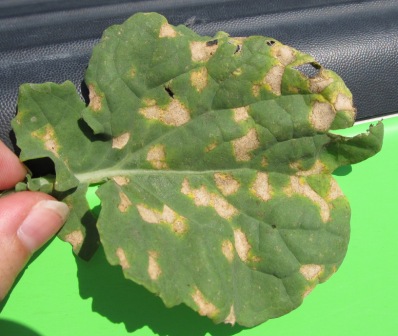
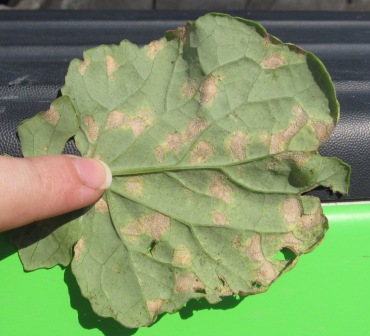
Typical symptoms of downy mildew on the upper surface (left) and underside (right) of a canola leaf.
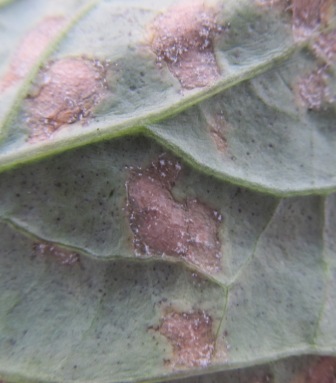
Close-up of mycelial growth on the underside of a canola leaf typical of downy mildew.
Surveys and Forecasts
Diamondback moth
Trap counts for adult moths were highest in the Eastern part of Manitoba. Highest trap counts are:
| Location | Total Count |
|---|---|
| Steinbach | 746 |
| Beausejour | 317 |
| Oldenburg | 306 |
| Morris | 275 |
| Dencross | 195 |
| River Hills | 163 |
| St. Elizabeth | 151 |
Traps for monitoring adults of diamondback moth can now be removed. Larvae can now be found in fields, and the focus now should be on scouting for the larvae.
A table showing the trap counts from the diamondback moth monitoring program can be found on the MAFRI website at: http://www.gov.mb.ca/agriculture/crops/seasonal-reports/pubs/diamondback-report-2013.pdf
Bertha Armyworm
The cumulative counts are still generally within the low risk zone, however a couple traps in the Central and Eastern regions of Manitoba are in the uncertain risk zone. One trap in the Elm Creek area had a high count last week (730 moths).
Trap counts are an indication of the risk within a general region, and hence the importance of looking for larvae on the ground when scouting canola fields. Traps do not necessarily indicate risk in the specific field the trap is in, as factors such as crop staging and how attractive to crops are to the egg-laying females will affect which fields within a region may have higher levels of larvae.
Highest cumulative trap counts to date are:
Risk of bertha armyworm based on moth capture in pheromone-baited traps 0-300 = Low risk 300-900= Uncertain risk 900-1,200= Moderate risk 1,200+= High risk | |
|---|---|
| Location | Total Count |
| Elm Creek | 730 U |
| Ridgeville | 327 U |
| Sperling | 209 L |
| Dominion City | 202 L |
| Gladstone | 127 L |
A table showing data from the bertha armyworm monitoring program can be viewed on the MAFRI website at:
Wheat Midge
Degree day (DD) models using a base temperature of 5C can be used to estimate the emergence of adult wheat midge. The map as of June 30th showed that emergence as of that date is not predicted to have started.
Emergence is likely to start near the end of the first week in July; we will post weekly maps to show how close we should be to 10%, 50% and 90% emergence.
693 DD = 10% emergence 784 DD = 50% emergence 874 DD = 90% emergence
Note that wheat is only susceptible to wheat midge from the time heads are first visible until flowering (when anthers are visible)
